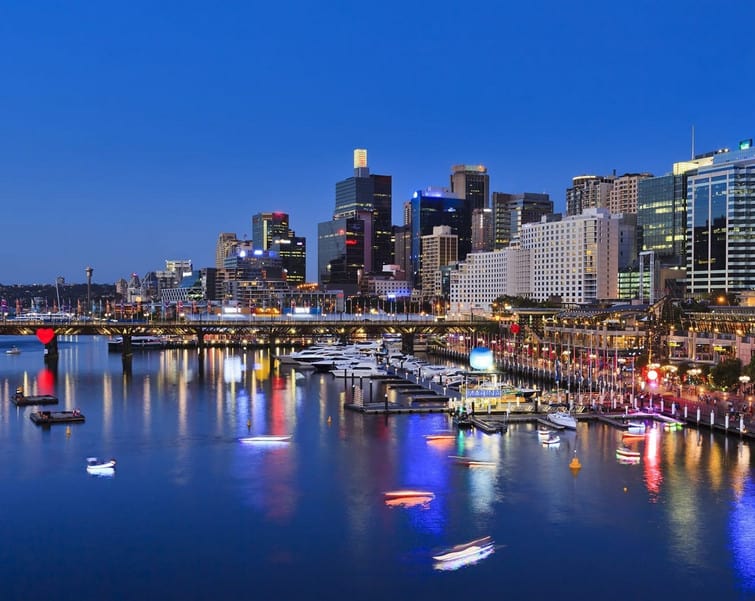Darling Harbour History
Darling Harbour, initially, was a boundary for seven centuries, separating the Gadigal and Wangal clans, who were known as the Eora people. They used to harbor and transport food along River Parramatta.
The area was popular for seafood. Its shores were always littered with shellfish remains and oyster shells. This is the reason why Europeans called the region Cockle Bay.

Image Source: rydges.com/accommodation/sydney-nsw/capitol-square-sydney/things-to-do/darling-harbour/
By 1788, the area witnessed numerous cases of diseases such as flu, colds, measles, and smallpox. The diseases mostly affected the Aboriginal people. The Eora population survived the diseases. Today, generations of the indigenous clans still reside in Sydney and its surroundings.
Long Cove, then Cockle Bay
The early European people who visited the harbour were mostly convicts, settlers, and lime burners. The eastern coast was depicted in 1800 by Charles Grimes, the first deputy to the surveyor general of NSW.
Initially, Darling Harbour was known as Long Cove. It was later renamed to Cockle Bay until 1826, after which the then Governor by the name Ralph Darling renamed the area after his name Darling.
Industrial and Maritime Development at the Harbour
The history behind the harbour revolves around ships, wharves and shipyards along the shores. There were many warehouses and factories that emerged in the area.
The Sydney Aquarium, for instance, stands at where Market Street Wharf was set up in 1820s. Other wharfs built in that era no longer exist.
Industrialization took over in the region in the nineteenth century. This is where the very first steam-driven engine started working in Australia in 1815. It drove an iron shop.
Other industrial innovations in the area were a gas company initiated in 1841. The following decade saw the coming up of a galvanizing plant.
During the 19th century, most cargos that passed in the region were wool, timber, coal, and wheat. From 1970s, the prime cargo was wool. In 1855, the first rail line passed through NSW.
A rail yard was set up in 1870s to house cargo transported by rail. Back then, Iron Wharf was the biggest structure made of steel.
The first freezing plant in the globe was built in 1861 in NSW. In 1880s, a pumping station was opened in NSW, and it used hydraulic systems. During the same century, a power station known as Ultimo started supplying electricity to power the very first electric powered trams.
Sydney households would be powered from the Pyrmont power station. Freezing plants were then established, with the first ever cargo ferrying frozen meat being shipped in 1877 to London.
After the 1890s, small scale industries were no longer the main thing. Wool stores and warehousing emerged as the main thing. By 1900, many wharves were set up in the region.
Rail yards expanded such that by 1891, most export produced in Australia was handled by these yards. The region continued thriving after 1900 as steam ships ferried cargo along the coast.
In 1902, Pyrmont Bridge was opened to replace a smaller one that has been constructed in 1857. The bridge maintained the main link between Pyrmont, Glebe, and the CBD.
It was a swing bridge that was electric powered from the Ultimo power plant. It is still the oldest electric powered swingspan type of bridge in operation today.
The WWI stimulated industrial growth and trade. However, in 1917, it contributed to the famous General Strike. Darling Harbour, in the 1930s, was largely affected by the famous Great Depression just like other industrial areas around the globe.
Casual laborers working at the wharves were hit hard. The war left many industries in the region decaying, with shopping trade along the coast disappearing. Business on the yards survived but by 1984, the industry came to an end.
Rebirth of the Darling Harbour Post 1980s
In 1984, Neville Wran, the then NSW premier, announced plans by the government to redevelop the harbour. In 1988, the harbour was officially opened by Queen Elizabeth the Second and it was returned to Sydney’s people to mark the bicentennial celebrations.
The Sydney Aquarium boasts as the very first attraction that was opened. It was followed by other museums, bars, hotels, restaurants, and shop. It became the heartbeat of Sydney.
In 1988, Cockle Bay was built to celebrate the harbour’s 10th birthday. The years that followed saw massive works in readiness for the Olympic Games held in Sydney in the year 2000.
Five Olympic sports were hosted in Darling Harbour. In 2009, there were numerous activities to celebrate the harbor’s 21st anniversary. The activities included multicultural festivals and publishing of a book on the harbour’s history.
You might also be interested in the Sydney Opera House & Harbour Bridge. Go here for more information: nbglandscapes.com.au/sydney-opera-house-harbour-bridge
NBG Landscapes Sydney
NBG Landscapes is a full service company for landscapes Sydney. Please reach out to our expert landscapers for a free consultation on your next landscaping project. NBG Landscapes is located very close to Darling Harbour, in Pyrmont.
NBG Landscapes
Address: 610/320 Harris St, Pyrmont NSW 2009, Australia
Phone: +61 422 246 213
Also Read
The Amazing Darling Harbour in Sydney NSW
